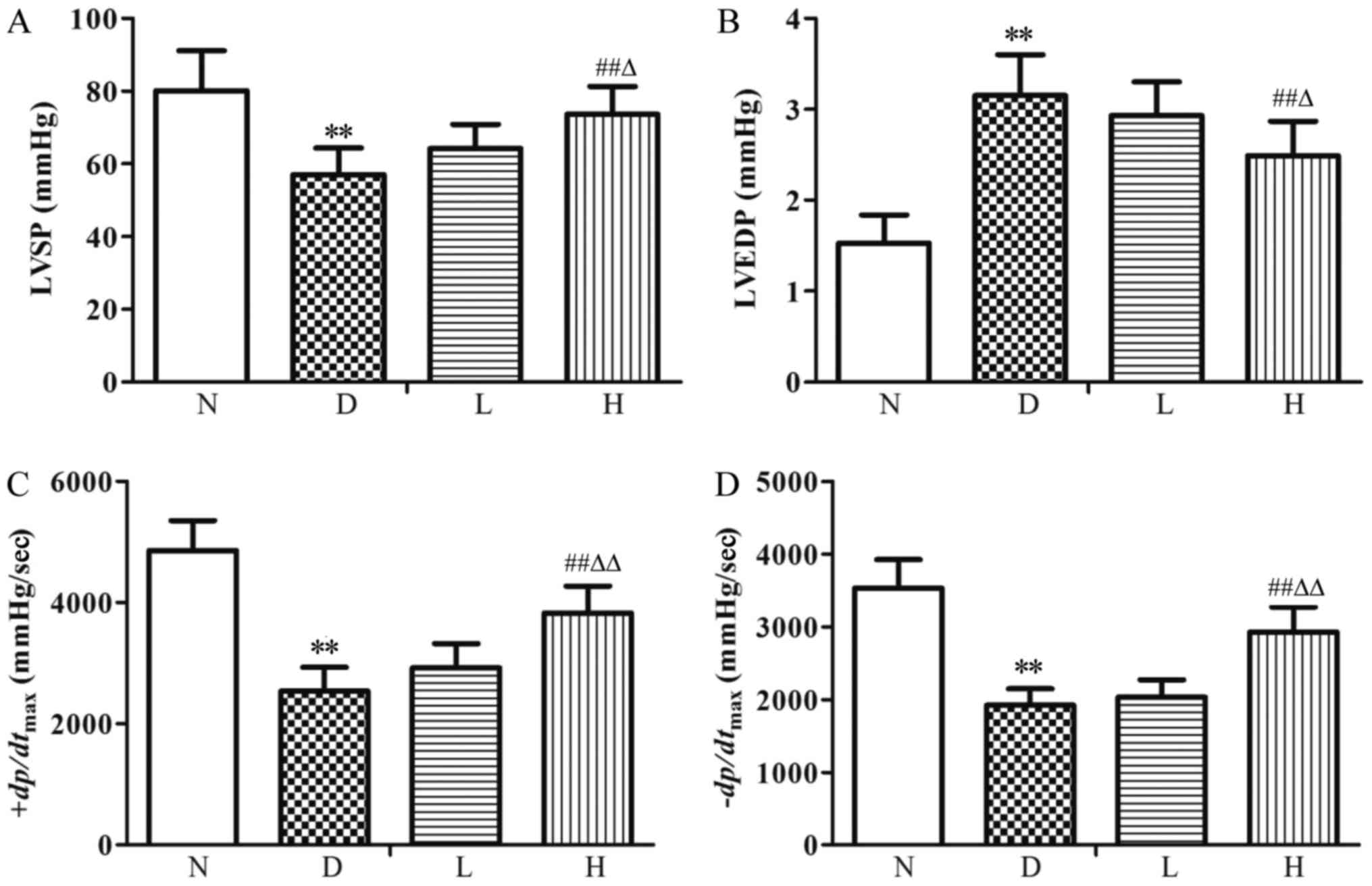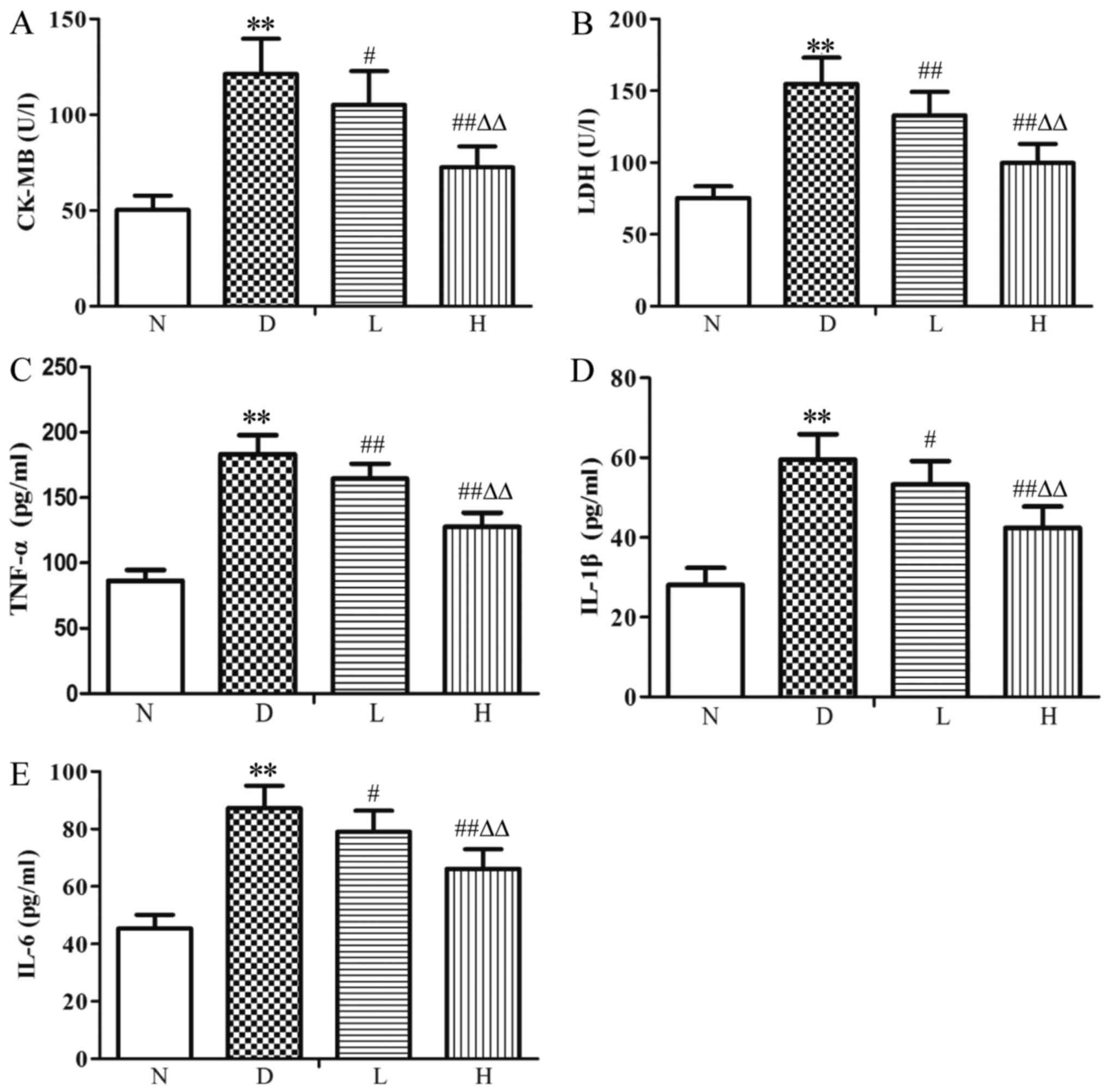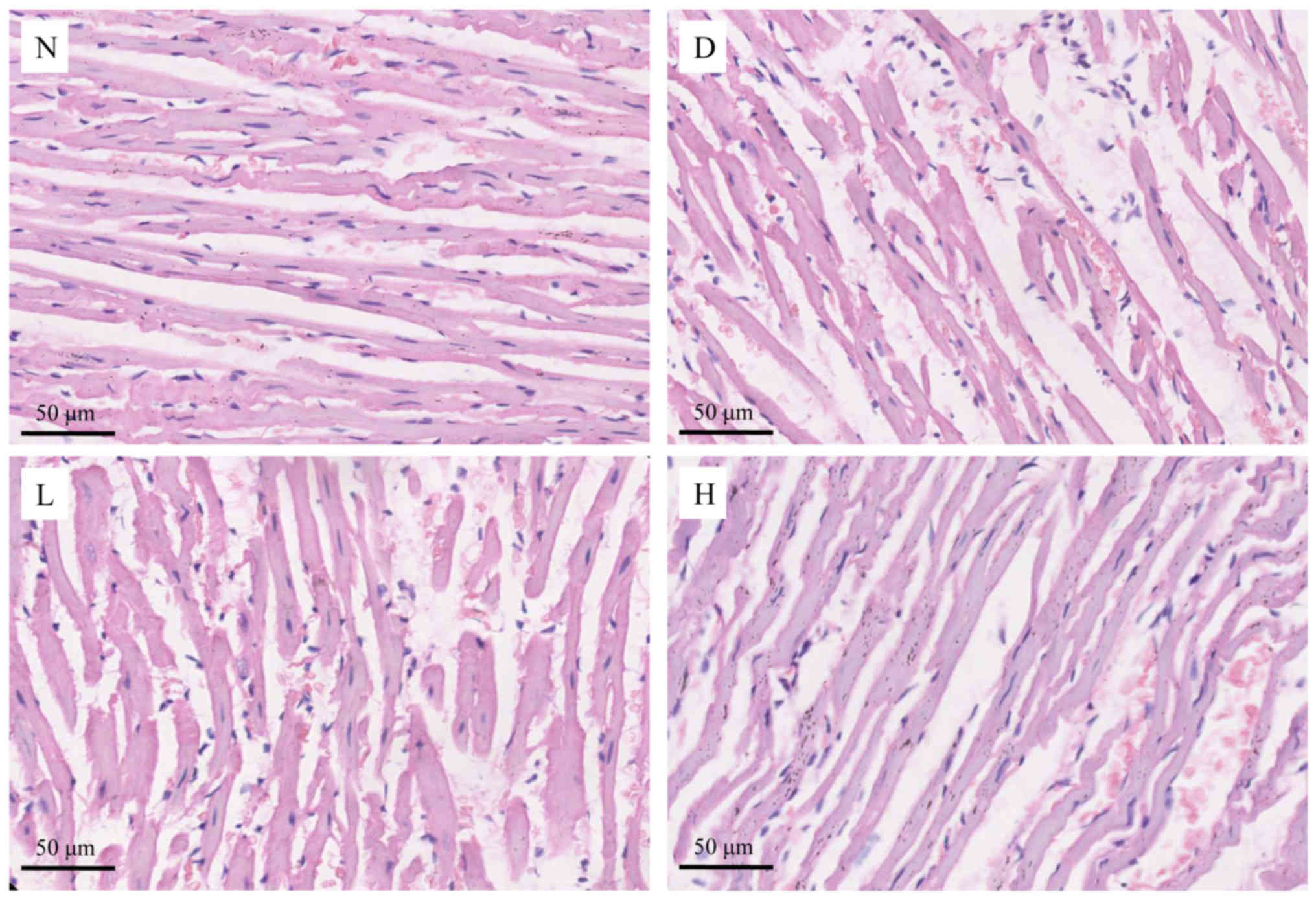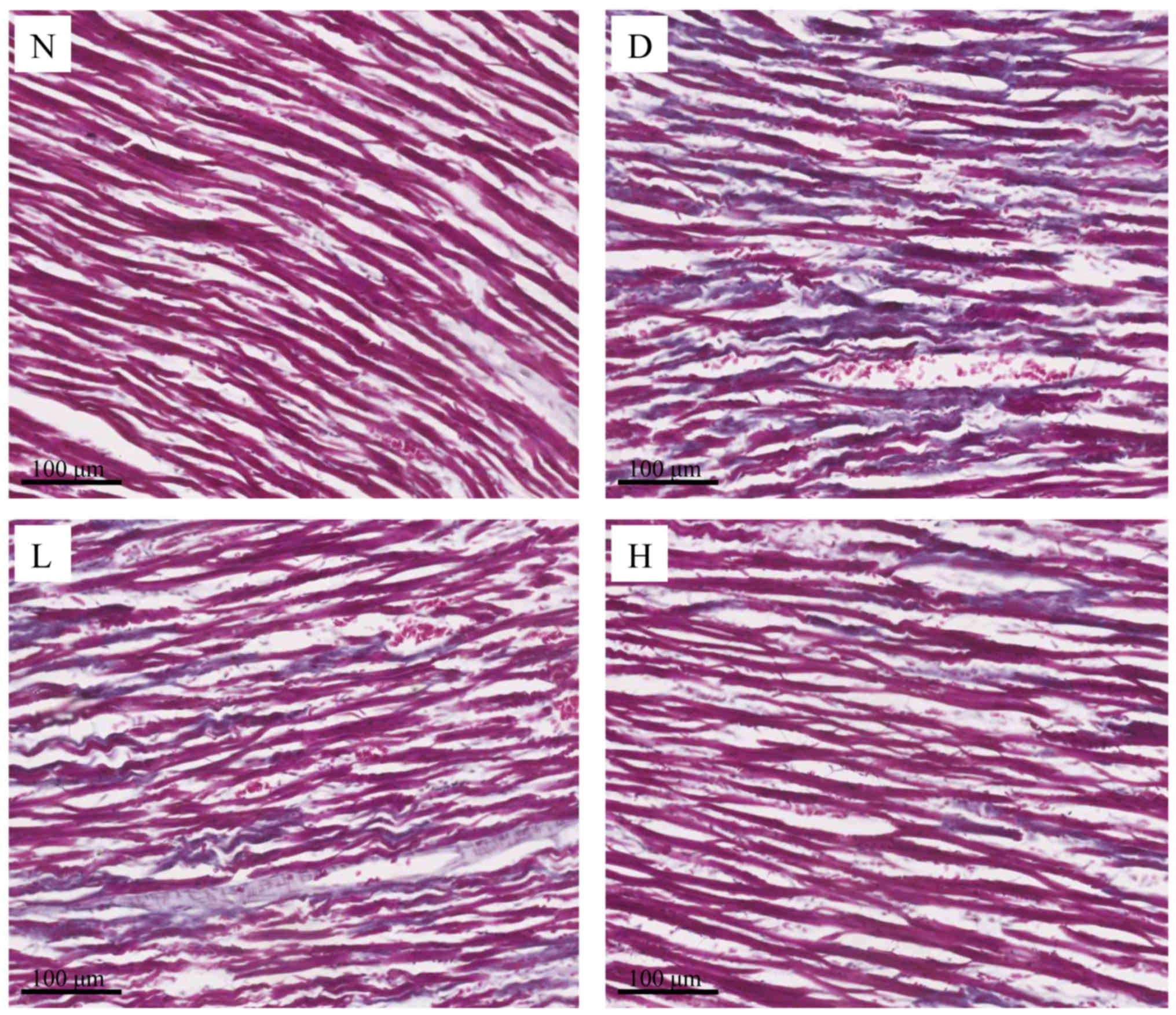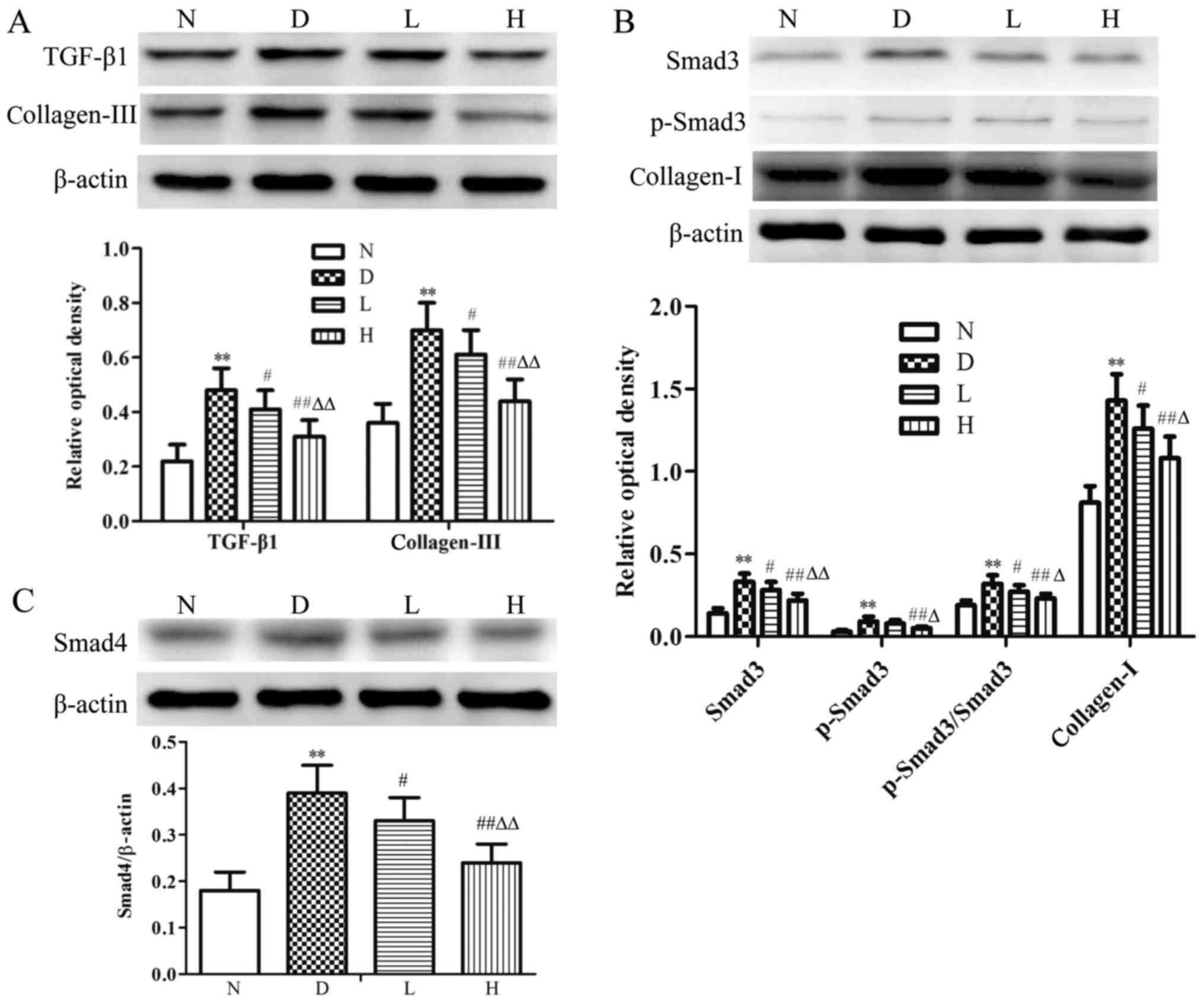Effect of genistein on myocardial fibrosis in diabetic rats and its mechanism
- Authors:
- Published online on: December 12, 2017 https://doi.org/10.3892/mmr.2017.8268
- Pages: 2929-2936
-
Copyright: © Yang et al. This is an open access article distributed under the terms of Creative Commons Attribution License.
Abstract
Introduction
Diabetes mellitus is one of the major public health problems around the world (1). According to the compiled data of the International Diabetes Federation, ~1 in 11 adults has diabetes mellitus worldwide, and the number of diabetic patients may reach 642 million by the year 2040.
Diabetic cardiomyopathy (DCM) is defined as the ventricular dysfunction in diabetic patients which do not rely on some causes, coronary artery disease, hypertension and so on. DCM is one of the main cardiovascular complications of diabetes which has become a major cause of morbidity and mortality in diabetic patients (2,3). Interstitial fibrosis is a histological hallmark of DCM (4,5).
The normal structure of heart is composed of several different cell types such as cardiomyocytes, cardiac fibroblasts, endothelial cells, smooth muscle cells and extracellular matrix (ECM) including collagens, larninin and fibrinogen (6,7). Excessive deposition of ECM is one of the important pathological alterations in diabetic hearts (8). Interstitial collagens such as collagen-I and collagen-III are the major components of ECM in heart, which play important roles in supporting and protecting cardiomyocytes and maintaining the normal structure and function of myocardial tissue ingredient. The excess production of collagen-I and collagen-III proteins may be responsible for myocardial interstitial collagen deposition, disorder, and even heart damage (9). An abnormal amount of collagen increases the hardness of the myocardium and reduces the diastolic function of the heart. With the increase of myocardial fibrosis, the myocardial systolic function is also damaged.
The isoflavone genistein (GEN; 4′,5,7-trihydroxyisoflavone), which is known to interact with estrogen receptors and has weak estrogenic activity, is a phytoestrogen found at high levels in soy products (10,11). Studies have demonstrated that GEN plays a critical role in anti-inflammatory, anti-oxidative and anti-proliferation effects (12,13). Recent research has shown that GEN can reduce cardiac inflammation and oxidative stress in DCM (14). GEN can also protect the liver from chronic injury in D-galactosamine-induced liver fibrosis by inhibiting accumulation of the collagen matrix, suppressing the expression of transforming growth factor-β (TGF-β) and activation of the TGF-β/Smad signaling pathway (15). However, it is not clear whether the TGF-β/Smad pathway is involved in the cardioprotective effect of GEN on myocardial fibrosis in diabetic rats. The purpose of the present study was to investigate the effects of GEN on myocardial fibrosis in type 1 diabetic rats and to elucidate the underlying mechanisms. This study may shed some light on GEN as a novel effective medicine in treating DCM.
Materials and methods
Animals
Male Sprague-Dawley rats (6–7 weeks of age, 160–200 g) were obtained from of Bengbu Medical College Animal Administration Center. The rats were given free access to normal diet and water, and housed in cages at room temperature (22±1°C) with a fixed 12 h light/dark cycle. All animal experiments were approved by the Animal Ethics Committee of Bengbu Medical College and conducted in accordance with ethical standards.
Chemicals and reagents
Streptozotocin and GEN were purchased from Sigma-Aldrich (St. Louis, MO, USA). Carboxymethylcellulose sodium (CMC-Na) was purchased from Shanghai Sangon Biological Engineering Co., Ltd., (Shanghai, China). Hydroxyproline (Hyp), creatine kinase MB isozyme (CK-MB), lactate dehydrogenase (LDH), tumor necrosis factor-α (TNF-α), interleukin-1β (IL-1β) and interleukin-6 (IL-6) assay kits were purchased from Nanjing Jiancheng Bioengineering Institute (Nanjing, Jiangsu, China). Bradford and bicinchoninic acid (BCA) protein assay kits were purchased from Beyotime Biotechnology (Shanghai, China). Rabbit TGF-β1, Smad3, phospho-Smad3 (p-Smad3) and Smad4 antibodies were purchased from Abcam (Cambridge, MA, USA). Rabbit collagen-I and collagen-III antibodies were purchased from Boster Biological Technology (Wuhan, Hubei, China). Rabbit β-actin antibody was purchased from Proteintech Group (Wuhan, Hubei, China). Goat anti-rabbit secondary antibody was purchased from Biosharp Biotechnology (Hefei, Anhui, China).
Induction of diabetes and experimental protocol
All rats were divided randomly into 4 groups: Normal control group (N), diabetic control group (D), low-dose GEN treatment group (L) and high-dose GEN treatment group (H) (n=8). Type 1 diabetes mellitus was induced in overnight fasted rats by administering a single intraperitoneal injection of 55 mg/kg streptozotocin freshly dissolved in 0.1 mol/l sodium citrate buffer (pH 4.5). The rats in the N group were received an intraperitoneal injection with the same volume of sodium citrate buffer. The rats with plasma fasting blood glucose (FBG) level >16.7 mmol/l (72 h after injection) were considered as type 1 diabetic rats. The FBG level was monitored once a week during the experimental period. After successful building models, from the fifth week, the rats in the L and H groups were daily gavaged with 5 and 25 mg/kg GEN solution (freshly dissolved in CMC-Na) for 4 weeks, respectively. The doses of GEN were chosen according to a method reported (16). The rats in the N and D groups were daily gavaged with the same volume of CMC-Na for 4 weeks.
Ventricular hemodynamic measurements
Rats were anaesthetized by intraperitoneal injection with chloral hydrate (100 mg/kg) and performed trachea cannula. Right carotid artery was separated and intubated to the left ventricle. Left ventricular systolic pressure (LVSP), left ventricular end-diastolic pressure (LVEDP) and maximal rise/fall rate of left ventricular pressure (± dp/dtmax) were recorded by the Med-Lab Biological Recording system (Medease Company, Nanjing, China).
Detection of FBG level, body-weight (BW), heart-weight (HW) and HW/BW
After ventricular hemodynamic measurement, the blood was collected and FBG level was measured. Rats were sacrificed and their hearts were excised rapidly to place in ice-cold normal saline, and HW/BW was calculated.
Determination of myocardial Hyp content
Heart tissue (0.1 g) was homogenized in 0.9 ml ice-cold normal saline. The supernatant was collected after centrifugation for 20 min (3,000 rpm/min). The protein concentration was measured by the Bradford protein assay kit. Hyp content was measured according to the instruction manual.
Determination of serum CK-MB, LDH, TNF-α, IL-1β and IL-6 levels
The blood was placed in centrifuge tubes and centrifuged at 3,000 rpm/min for 20 min. The supernatant was collected. CK-MB, LDH, TNF-α, IL-1β and IL-6 levels were measured using the corresponding assay kits according to kit instructions.
Histomorphological observation by hematoxylin and eosin (H&E) staining and Masson's trichrome staining
Fresh myocardial tissue was fixed in 4% paraformaldehyde, embedded in paraffin, and cut into 5 µm thick serial sections. After de-waxed, the sections were stained with H&E and Masson's trichrome, respectively.
Ultrastructure observation under transmission electron microscope
Fresh myocardial tissues were cut into the size of 1×1×1 mm, fixed in ice-cold 2.5% glutaraldehyde for 2 h, and post-fixed in 1% osmium tetroxide for 1 h. Ultrathin sections stained with uranyl acetate and lead citrate were observed with JEM-1230 transmission electron microscope (JEOL, Tokyo, Japan).
Detection of TGF-β1, Smad3, p-Smad3, Smad4, collagen-I and collagen-III protein by western blot analysis
Myocardial tissue (0.1 g) was collected and homogenized in 1 ml protein extraction buffer (990 µl lysis buffer + 10 µl Phenylmethanesulfonyl fluoride). The supernatant was collected and protein concentration was measured using the BCA protein assay kit. Proteins (50 µg) were separated using sodium dodecyl sulfate-polyacrylamide gel electrophoresis and transferred onto polyvinylidene difluoride membranes. Membrane with p-Smad3 was blocked in Tris buffered saline Tween-20 (TBST) containing 5% bovine serum albumin, and membranes with TGF-β1, Smad3, Smad4, collagen-I, collagen-III and β-actin were blocked in TBST containing 5% nonfat milk at 37°C for 2 h, and then they were incubated overnight at 4°C with the following primary antibodies: Anti-TGF-β1 (1:1,000), anti-Smad3 (1:1,000), anti-p-Smad3 (1:1,000), anti-Smad4 (1:1,000), anti-collagen-I (1:400), anti-collagen-III (1:400) and anti-β-actin (1:2,000). Membranes were then washed with TBST and incubated with a horseradish peroxidase conjugated goat anti-rabbit IgG secondary antibody for 1 h at room temperature. Autoradiographs were scanned with ChemiDoc XRS system (Bio-Rad, Berkeley, CA, USA) and the band density was determined with Quantity One software.
Statistical analysis
Data were expressed as mean ± SD. Statistical comparisons were performed by one-way analysis of variance and the Newman-Keuls test. P<0.05 was considered to indicate a statistically significant difference.
Results
Changes of ventricular hemodynamic parameters
Compared with the N group, LVSP and ±dp/dtmax were decreased (P<0.01) significantly, while LVEDP was increased (P<0.01) significantly in the D group; Compared with the D group, there were no statistical differences in ventricular hemodynamic parameters in the L group; LVSP and ± dp/dtmax were increased (P<0.01) significantly, LVEDP was decreased (P<0.01) in the H group. Compared with the L group, LVSP and ±dp/dtmax were increased (P<0.05, P<0.01), while LVEDP was decreased (P<0.05) in the H group (Fig. 1).
Changes of FBG, BW, HW, HW/BW and Hyp content
Compared with the N group, BW and HW were decreased (P<0.01), while FBG, HW/BW and Hyp content were significantly increased (P<0.01) in the D group. Compared with the D group, there were no statistical differences in FBG and HW in the L group, BW was increased (P<0.05), while HW/BW and Hyp content were decreased (P<0.05); in the H group, there was no statistical difference in FBG, while BW and HW were increased (P<0.01), HW/BW and Hyp content were significantly decreased (P<0.01). Compared with the L group, BW and HW were increased (P<0.01), while HW/BW and Hyp content were decreased (P<0.05, P<0.01) in the H group (Table I).
Table I.Fasting blood glucose, body and heart weight and the ratio, and hydroxyproline content in the different groups. |
Changes of serum CK-MB, LDH, TNF-α, IL-1β and IL-6 levels
Compared with the N group, serum CK-MB, LDH, TNF-α, IL-1β and IL-6 levels were increased (P<0.01) in the D group; Compared with the D group, CK-MB, LDH, TNF-α, IL-1β and IL-6 levels were decreased (P<0.05, P<0.01) in the L group; CK-MB, LDH, TNF-α, IL-1β and IL-6 levels were decreased (P<0.01) in the H group. Compared with the L group, CK-MB, LDH, TNF-α, IL-1β and IL-6 levels were decreased (P<0.01) in the H group (Fig. 2).
Histological changes in myocardial tissue by H&E staining
In the N group, the myocardial fibers were arranged in neat rows, the myocardial nuclei were clear, the myocardial gap was normal and inflammatory cells soak was rare. In the D group, the myocardial fibers were disordered, the cardiomyocytes were swollen significantly and myocardial gap was widened. Inflammatory cells were infiltrated significantly and the distribution of cytoplasm was uneven in the D group. Compared with the D group, the myocardial damage in the L group was relatively ameliorated, however, the arrangement of myocardial fibers was disordered and inflammatory cell infiltration was observed. The myocardial damage in the H group was obviously ameliorated, most of the myocardial cells were arranged neatly and the infiltration of inflammatory cells was significantly reduced (Fig. 3).
The morphology of collagen detection by Masson's trichrome staining
In Masson's trichrome staining, the collagen fibers were stained blue and cardiomyocytes were stained red. In the N group, the myocardial fibers were arranged in neat row and the myocardial gap was normal. The interstitial collagen fibers were rare. In the D group, the cardiomyocytes were in a disordered arrangement, the myocardial gap was widened and the interstitial collagen fibers were increased obviously. Treated with GEN, the cardiomyocytes were disrupted in some areas and collagen fibers were decreased slightly in the L group; in the H group, the cardiomyocytes were approximately arranged neatly, collagen fibers were sparsely distributed, and interstitial collagen was dyed a little blue (Fig. 4).
Changes in the myocardial ultrastructure
In the N group, the sarcomeres of the myocardium were arranged orderly and maintained homogenous length; intermyofibrillar mitochondria were arranged in an ordered pattern in myocardium. In the D group, the integrity of the cardiomyocyte was destroyed and mitochondrial matrix was severely damaged. In addition, the collagen fibers were found (shown with black arrows), which indicated the severity of myocardial fibrosis. After treatment with GEN, compared with the D group, myocardial injury was alleviated in the L group; these injuries were significantly ameliorated in the H group (Fig. 5).
Changes in myocardial TGF-β1, Smad3, p-Smad3, Smad4, collagen-I and collagen-III at protein levels
Compared with the N group, levels of myocardial TGF-β1, Smad3, p-Smad3, p-Smad3/Smad3, Smad4, collagen-I and collagen-III were significantly increased (P<0.01) in the D group. In contrast to D group, there was no statistical difference in p-Smad3 expression, the levels of myocardial TGF-β1, Smad3, p-Smad3/Smad3, Smad4, collagen-I and collagen-III were decreased (P<0.05) in the L group; the levels of myocardial TGF-β1, Smad3, p-Smad3, p-Smad3/Smad3, Smad4, collagen-I and collagen-III were significantly decreased (P<0.01) in the H group. Compared with the L group, the aforementioned indices were decreased (P<0.05, P<0.01) in the H group (Fig. 6).
Discussion
DCM is one of the most common complications of diabetes, which major pathological characteristics are hypertrophy or hyperplasia in cardiomyocytes. Excessive deposition of myocardial interstitial collagen and myocardial fibrosis often leads to cardiac hypertrophy and heart dysfunction, which plays an important role in the occurrence and development of DCM (17).
The results in the present study showed that compared with the N group, FBG, LVEDP and HW/BW were increased significantly in the D group, while LVSP and ±dp/dtmax were decreased significantly, which indicated the heart dysfunction and cardiomyocyte hypertrophy in diabetic rats. In addition, there were histomorphological changes and ultrastructure damage in the D group. The serum CK-MB, LDH, TNF-α, IL-1β and IL-6 levels, Hyp content and the protein expression of collagen-I and collagen-III in the D group were significantly increased compared with the N group, which indicated that myocardial injury, inflammatory reaction and myocardial fibrosis were significantly aggravated in diabetic rats.
GEN is a type of plant estrogens, which exhibits antioxidant, anti-inflammatory and anti-apoptotic effects. GEN can prevent isoproterenol-induced cardiac hypertrophy in rats (18) and ameliorate adverse cardiac effects induced by arsenic trioxide through preventing cardiomyocytes apoptosis (19). In the present study, we investigated the protective effects of low- and high-dose GEN on myocardial tissue in diabetic rats. Compared with the D group, the data showed that, although there was no statistical difference in cardiac function in the L group, the cardiac diastolic and systolic functions were improved in the H group. In addition, HW/BW and the levels of TNF-α, IL-1β and IL-6 were decreased in the L and H groups. It is suggested that GEN can alleviate myocardial hypertrophic changes and inflammatory reaction to improve cardiac function, which indicated that GEN has a protective effect in DCM.
In myocardial injury, CK-MB and LDH are two specific indicators. CK-MB is a key enzyme in the energy metabolism of cardiomyocytes, and LDH is an important dehydrogenase in the process of anaerobic glycolysis (20). CK-MB and LDH activities were low in the serum under normal physiological conditions. When the myocardium injured and the cell membrane permeability changing, leakage of intracellular proteins such as CK-MB and LDH could occur. CK-MB and LDH activities were significantly increased in the serum, which indicated that the degree of myocardial injury was aggravated. Schmidt et al (21) reported that GEN can reduce LDH release and inhibit proliferation of malignant glioma cells by inhibiting protein tyrosine kinase activity. This study showed that compared with N group, serum CK-MB and LDH activities were significantly increased in the D group. After treating diabetic rats with GEN, serum CK-MB and LDH activities were decreased in the L and H groups. The results suggested that GEN can alleviate myocardial injury through reducing CK-MB and LDH leakage in diabetic rats.
In addition, some studies have reported that GEN, which has anti-proliferative activity in many cell types and inhibits tyrosine kinases, may benefit the cardiovascular system. GEN can inhibit aortic smooth muscle cell proliferation in rat (22) and abolish nucleoside uptake by cardiac fibroblasts in vitro (23). Therefore, this raises the question as to the exact mechanism by which GEN exerts its cardioprotective effect in diabetic rat and whether the mechanism is associated with regulation of myocardial collagen expression.
Evidence from human and experimental models of DCM has implicated cardiac fibrosis as a strong pathological contributor (24,25). Cardiac fibrosis can increase left ventricle stiffness and decrease ventricular wall compliance, and these results in systolic and in particular diastolic dysfunction (26). Excess ECM, which is caused by an imbalance between synthesis and degradation, plays an important role in cardiac fibrosis. Therefore, the content of ECM can be used to assess the degree of myocardial fibrosis. In heart, the major components of ECM are interstitial collagens such as collagen-I and collagen-III. Collagen-I accounts for 80% of total collagen in the heart and the fiber is thick with good toughness and strong anti-stretch function; collagen-III accounts for 11% of total collagen and the fiber is thin with good stretch to maintain the heart elasticity. Therefore, cardiac dysfunction would happen when excessive deposition of these two collagens disrupts the structure of the heart. Compared with the N group, data showed that collagen-I and collagen-III protein expressions were significantly increased in diabetic rats, which verified that myocardial collagen content increased could aggravate the degree of fibrosis. In contrast to D group, the protein expression of collagen-I and collagen-III were significantly decreased in the L and H groups. We suggest that GEN exhibits cardioprotective effect through inhibiting the excessive production of myocardial collagen and alleviating myocardial fibrosis in diabetic rats.
TGF-β1 is a key signaling molecule to induce cardiac fibrosis by activating the proliferation and collagen production of cardiac fibroblasts, and plays a significant role in the development and progression of ECM metabolism (27). On the one hand, TGF-β1 can directly induce the activation of ECM gene transcription and high expression; on the other hand, TGF-β1 can suppress the degradation of ECM by inhibiting matrix metalloproteinases and inducing tissue inhibitor of metalloproteinase, which may lead to a deterioration in myocardial injury and the occurrence and development of myocardial fibrosis (28).
Smads are pivotal intracellular nuclear effectors of TGF-β1 family members (29). Ligand-induced activation of TGF-β family receptors with intrinsic serine/threonine kinase activity triggers phosphorylation of receptor-regulated Smads. Of these, Smad3 is phosphorylated by TGF-β1, followed by binding with Smad4 to form a complex that translocates to the nucleus. This signaling cascade finally produces fibrotic mediators such as collagens (30,31). Many studies have found that the TGF-β1/Smad3 signaling pathway mediates a number of fibrotic diseases, such as hepatic fibrosis (32) and pulmonary fibrosis (33). Our data also showed that compared with the N group, the protein expression of TGF-β1, Smad3, p-Smad3 and Smad4 were significantly increased in the D group, this confirmed that the TGF-β1/Smad3 pathway was involved in myocardial fibrosis in diabetic rats. After treating diabetic rats with GEN, the results showed that the expression levels of TGF-β1, Smad3, p-Smad3/Smad3 and Smad4 were decreased in the L and H groups, and this decrease was positively correlated with the dose of GEN. Thus, we suggest that GEN can inhibit the TGF-β1/Smad3 signaling pathway to regulate the collagens expression in DCM.
In conclusion, GEN can attenuate myocardial fibrosis in type 1 diabetic rats, and the underlying mechanism may be associated with the reduction of CK-MB and LDH leakage, inhibition of inflammatory reaction, and suppression of the TGF-β1/Smad3 signaling pathway to regulate the collagens expression.
Acknowledgements
The present study was supported by the Natural Science Research Project of the Education Commission of Anhui Province (KJ2017A216), the Natural Science Research Project of Bengbu Medical College (BYKY1621ZD), and the National Undergraduate Innovation and Entrepreneurship Program (201510367009), China.
References
|
Mohan V, Seedat YK and Pradeepa R: The rising burden of diabetes and hypertension in southeast Asian and African regions: Need for effective strategies for prevention and control in primary health care settings. Int J Hypertens. 2013:4090832013. View Article : Google Scholar : PubMed/NCBI | |
|
Ward ML and Crossman DJ: Mechanisms underlying the impaired contractility of diabetic cardiomyopathy. World J Cardiol. 6:577–584. 2014. View Article : Google Scholar : PubMed/NCBI | |
|
Aneja A, Tang WH, Bansilal S, Garcia MJ and Farkouh ME: Diabetic cardiomyopathy: Insights into pathogenesis, diagnostic challenges and therapeutic options. Am J Med. 121:748–757. 2008. View Article : Google Scholar : PubMed/NCBI | |
|
Miki T, Yuda S, Kouzu H and Miura T: Diabetic cardiomyopathy: Pathophysiology and clinical features. Heart Fail Rev. 18:149–166. 2013. View Article : Google Scholar : PubMed/NCBI | |
|
Hu X, Bai T, Xu Z, Liu Q, Zheng Y and Cai L: Pathophysiological fundamentals of diabetic cardiomyopathy. Compr Physiol. 7:693–711. 2017. View Article : Google Scholar : PubMed/NCBI | |
|
Fujiu K, Wang J and Nagai R: Cardioprotective function of cardiac macrophages. Cardiovasc Res. 102:232–239. 2014. View Article : Google Scholar : PubMed/NCBI | |
|
Cunnington RH, Nazari M and Dixon IM: c-Ski, Smurf2 and Arkadia as regulators of TGF-beta signaling: New targets for managing myofibroblast function and cardiac fibrosis. Can J Physiol Pharmacol. 87:764–772. 2009. View Article : Google Scholar : PubMed/NCBI | |
|
Liu X, Liang E, Song X, Du Z, Zhang Y and Zhao Y: Inhibition of Pin1 alleviates myocardial fibrosis and dysfunction in STZ-induced diabetic mice. Biochem Biophys Res Commun. 479:109–115. 2016. View Article : Google Scholar : PubMed/NCBI | |
|
Zhang Y, Zhang L, Zhang Y, Xu JJ, Sun LL and Li SZ: The protective role of liquiritin in high fructose-induced myocardial fibrosis via inhibiting NF-κB and MAPK signaling pathway. Biomed Pharmacother. 84:1337–1349. 2016. View Article : Google Scholar : PubMed/NCBI | |
|
Patisaul HB and Jefferson W: The pros and cons of phytoestrogens. Front Neuroendocrinol. 31:400–419. 2010. View Article : Google Scholar : PubMed/NCBI | |
|
Guo TL, Germolec DR, Zheng JF, Kooistra L, Auttachoat W, Smith MJ, White KL and Elmore SA: Genistein protects female nonobese diabetic mice from developing type 1 diabetes when fed a soy- and alfalfa-free diet. Toxicol Pathol. 43:435–448. 2015. View Article : Google Scholar : PubMed/NCBI | |
|
Elmarakby AA, Ibrahim AS, Faulkner J, Mozaffari MS, Liou GI and Abdelsayed R: Tyrosine kinase inhibitor, genistein, reduces renal inflammation and injury in streptozotocin-induced diabetic mice. Vascul Pharmacol. 55:149–156. 2011. View Article : Google Scholar : PubMed/NCBI | |
|
Kim MJ and Lim Y: Protective effect of short-term genistein supplementation on the early stage in diabetes-induced renal damage. Mediators inflamm. 2013:5102122013. View Article : Google Scholar : PubMed/NCBI | |
|
Gupta SK, Dongare S, Mathur R, Mohanty IR, Srivastava S, Mathur S and Nag TC: Genistein ameliorates cardiac inflammation and oxidative stress in streptozotocin-induced diabetic cardiomyopathy in rats. Mol Cell Biochem. 408:63–72. 2015. View Article : Google Scholar : PubMed/NCBI | |
|
Ganai AA and Husain M: Genistein attenuates D-GalN induced liver fibrosis/chronic liver damage in rats by blocking the TGF-β/Smad signaling pathways. Chem Biol Interact. 261:80–85. 2017. View Article : Google Scholar : PubMed/NCBI | |
|
Sung MJ, Kim DH, Jung YJ, Kang KP, Lee AS, Lee S, Kim W, Davaatseren M, Hwang JT, Kim HJ, et al: Genistein protects the kidney from cisplatin-induced injury. Kidney Int. 74:1538–1547. 2008. View Article : Google Scholar : PubMed/NCBI | |
|
Kayama Y, Raaz U, Jagger A, Adam M, Schellinger IN, Sakamoto M, Suzuki H, Toyama K, Spin JM and Tsao PS: Diabetic cardiovascular disease induced by oxidative stress. Int J Mol Sci. 16:25234–25263. 2015. View Article : Google Scholar : PubMed/NCBI | |
|
Maulik SK, Prabhakar P, Dinda AK and Seth S: Genistein prevents isoproterenol-induced cardiac hypertrophy in rats. Can J Physiol Pharmacol. 90:1117–1125. 2012. View Article : Google Scholar : PubMed/NCBI | |
|
Fan Y, Wang C, Zhang Y, Hang P, Liu Y, Pan Z, Wang N and Du Z: Genistein ameliorates adverse cardiac effects induced by arsenic trioxide through preventing cardiomyocytes apoptosis. Cell Physiol Biochem. 31:80–91. 2013. View Article : Google Scholar : PubMed/NCBI | |
|
Yu Y, Jia XJ, Zong QF, Zhang GJ, Ye HW, Hu J, Gao Q and Guan SD: Remote ischemic postconditioning protects the heart by upregulating ALDH2 expression levels through the PI3K/Akt signaling pathway. Mol Med Rep. 10:536–542. 2014. View Article : Google Scholar : PubMed/NCBI | |
|
Schmidt F, Knobbe CB, Frank B, Wolburg H and Weller M: The topoisomerase II inhibitor, GEN, induces G2/M arrest and apoptosis in human malignant glioma cell lines. Oncol Rep. 19:1061–1066. 2008.PubMed/NCBI | |
|
Yu JY, Lee JJ, Lim Y, Kim TJ, Jin YR, Sheen YY and Yun YP: Genistein inhibits rat aortic smooth muscle cell proliferation through the induction of p27kip1. J Pharmacol Sci. 107:90–98. 2008. View Article : Google Scholar : PubMed/NCBI | |
|
Pillai MS and Shivakumar K: Genistein abolishes nucleoside uptake by cardiac fibroblasts. Mol Cell Biochem. 332:121–125. 2009. View Article : Google Scholar : PubMed/NCBI | |
|
Kain V, Kumar S and Sitasawad SL: Azelnidipine prevents cardiac dysfunction in streptozotocin-diabetic rats by reducing intracellular calcium accumulation, oxidative stress and apoptosis. Cardiovasc Diabetol. 10:972011. View Article : Google Scholar : PubMed/NCBI | |
|
Li CJ, Lv L, Li H and Yu DM: Cardiac fibrosis and dysfunction in experimental diabetic cardiomyopathy are ameliorated by alpha-lipoic acid. Cardiovasc Diabetol. 11:732012. View Article : Google Scholar : PubMed/NCBI | |
|
Asbun J and Villarreal FJ: The pathogenesis of myocardial fibrosis in the setting of diabetic cardiomyopathy. J Am Coll Cardiol. 47:693–700. 2006. View Article : Google Scholar : PubMed/NCBI | |
|
Pan Z, Zhao W, Zhang X, Wang B, Wang J, Sun X, Liu X, Feng S, Yang B and Lu Y: Scutellarin alleviates interstitial fibrosis and cardiac dysfunction of infarct rats by inhibiting TGF-β1 expression and activation of p38-MAPK and ERK1/2. Br J Pharmacol. 162:688–700. 2011. View Article : Google Scholar : PubMed/NCBI | |
|
Cutroneo KR: TGF-beta-induced fibrosis and SMAD signaling: Oligo decoys as natural therapeutics for inhibition of tissue fibrosis and scarring. Wound Repair Regen. 15 Suppl 1:S54–S60. 2007. View Article : Google Scholar : PubMed/NCBI | |
|
Itoh S, Itoh F, Goumans MJ and Ten Dijke P: Signaling of transforming growth factor-beta family members through Smad protein. Eur J Biochem. 267:6954–6967. 2000. View Article : Google Scholar : PubMed/NCBI | |
|
Hata A and Chen YG: TGF-β signaling from receptors to smads. Cold Spring Harb Perspect Biol. 8:a0022612016. View Article : Google Scholar | |
|
Ko JW, Shin NR, Park SH, Kim JS, Cho YK, Kim JC, Shin IS and Shin DH: Pine bark extract (Pycnogenol®) suppresses cigarette smoke-induced fibrotic response via transforming growth factor-β1/Smad family member 2/3 signaling. Lab Anim Res. 33:76–83. 2017. View Article : Google Scholar : PubMed/NCBI | |
|
Xu F, Liu C, Zhou D and Zhang L: TGF-β/SMAD pathway and its regulation in hepatic fibrosis. J Histochem Cytochem. 64:157–167. 2016. View Article : Google Scholar : PubMed/NCBI | |
|
Jeon WY, Shin IS, Shin HK, Jin SE and Lee MY: Aqueous extract of gumiganghwaltang, a traditional herbal medicine, reduces pulmonary fibrosis by transforming growth factor-β1/Smad signaling pathway in murine model of chronic asthma. PLoS One. 11:e01648332016. View Article : Google Scholar : PubMed/NCBI |



